The Mentor, No. 30, Furniture and its Makers
The Mentor
“A Wise and Faithful Guide and Friend”
Vol. 1 No. 30
FURNITURE AND ITS MAKERS
CHARLES ANDRÉ BOULLE
DANIEL MAROT
J. HENRI RIESENER
THOMAS CHIPPENDALE
THOMAS SHERATON
GEORGE HEPPELWHITE

By PROFESSOR C. R. RICHARDS
Director of Cooper Union, New York.
It is rather surprising to find how late a development furniture is in the modern sense. Up to the seventeenth century chairs were far from common. Outside of the large and heavy armchairs reserved for the head of the family, benches, chests, and stools were the only seats in all but the wealthiest households. Before the sixteenth century fixed tables were unusual. Dining tables were almost always composed of a set of boards placed upon trestles at mealtime. Going a little further back to the fourteenth century we find furniture, even in castles of the nobility, of the scantiest and simplest. In the sleeping rooms the pieces were limited to a bed, one or two chests, a bench before the fireplace, and seats built into the wall, commonly under the windows. In the hall where meals were served the only indispensable article besides the trestle tables and benches was a dressoir or buffet for the display of plate. All of these pieces were exceedingly heavy and massive, and oftentimes built into the structure of the room. Not until the seventeenth century did furniture become lighter, more easily movable, and more comfortable. It was at this period that chairs began to be made with sloping backs and furnished with cushioned seats of leather or woven stuff.

LOUIS XIV CABINET
EXAMPLE OF BOULLE
Every age has impressed its artistic standards strongly upon the furniture of the period. Long after Gothic cathedral building had ceased, the cabinetmakers of northern Europe continued to carve their delicate window tracery upon the panels of chests and buffets and to copy the moldings of pier and mullion.

FRENCH OR FLEMISH CABINET OF THE FIFTEENTH CENTURY
The Renaissance brought a great change in the surface appearance of furniture, and in Italy, France, Flanders, and Germany the new art spirit manifested itself in different forms, each of which reflected the peculiar genius of the people of the land.
But all the earlier developments in furniture were overshadowed by the splendid achievements of French art in the latter part of the seventeenth century. These began under Louis XIV, and continued with undiminished productiveness and refinement of design through the reigns of Louis XV and Louis XVI, to a decline under the Empire.
LOUIS XV—FURNITURE OF THE BOUDOIR
The foundation by Colbert, minister of Louis XIV, of the Manufactures Royales des Meubles de la Couronne, commonly called the Gobelins, brought together for the production of furniture and tapestry for the royal palaces the most talented designers and expert craftsmen of the time. Of these Charles André Boulle was the master cabinetmaker. His name is commonly identified with marquetry of tortoise shell and brass, which he carried to a high state of perfection; but he was much more than a craftsman. He developed a furniture style that harmonized perfectly in its vigor and magnificence with the splendid proportions of the great royal residences. Large in scale and massive in construction, his pieces rely for their effect upon bold and striking decoration of gilded bronze and marquetry.

AN EXAMPLE OF RIESENER MARQUETRY
STYLE OF LOUIS XV
Boulle’s pieces accord thoroughly with the years of pomp and splendor of Le Grand Monarque; but even before the death of Louis a notable change in the appearance of furniture set in. The nobility, whose resources had been severely strained to maintain the splendor set by the king, found it necessary to substitute smaller apartments for their great rooms and galleries. Moreover, the heroic quality of the earlier Louis XIV decorations was no longer suited to the growing softness and effeminacy of the age. Smaller and more delicate furnishings were demanded. The Louis XIV chairs had borrowed the high upholstered backs, together with the S curves for arms and legs, from the Italians—later on the bold bombé curve appeared in the supports of the tables. By the time of the Regency these outlines had become more slender and refined and the reign of the curved line in furniture became established,—a reign that lasted for fully half a century, during which time some of the ablest masters of design that have ever lived played and conjured with curves delicate and curves bold, now bringing forth an outline pure and exquisite in quality, and again with amazing inventiveness interlacing curve with curve in combinations of infinite variety and bewildering richness.
Most Louis XV furniture develops naturally from that of Louis XIV, and is built upon thoroughly structural lines. The reaction, however, against severity and the increasing demand of a frivolous aristocracy for new and more striking effects, gradually produced a style in which decoration was often not subordinated to structure, but made an end in itself.
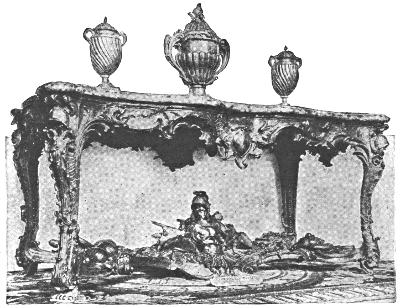
LOUIS XV TABLE
The rococo (from rocaille, rock, and coquille, shell) ran its extravagant course with increasing exaggeration and license during the first half of the reign of Louis XV; but it should not be thought of as affecting all the furniture even of this period, for its manifestations were mainly in the field of the carver and bronze worker, and the outlines of furniture were very little influenced, except in the case of the smaller and lighter pieces, such as console tables. About the middle of the reign the limit of artistic license had been passed and a reaction set in. The ormolu, which had reached excessive size and had become overloaded on the surface, was withdrawn to the edges, and made smaller and more suitable for the delicate proportions of the pieces. In its place marquetry of beautiful colored woods, more or less practised for over a century, was brought to a perfection never before equaled.

LOUIS XV COMMODE
LOUIS XVI—THE INFLUENCE OF THE CLASSIC
The reaction against the excesses of the rococo which had set in as early as the middle of the eighteenth century continued to gain strength during the next two decades, and to carry the design of furniture farther and farther from the fashion of the early years of Louis XV.

LOUIS XVI COMMODE
The new impulse turned naturally to the straight contour. This meant almost inevitably the adoption of classic lines. At first the change showed itself in the straightened bodies of commodes, cabinets, and writing tables, which still retained their curved supports. Finally the legs themselves were made straight or rather tapering; until by the end of the reign of Louis XV the curved outline had quite disappeared and the style called Louis XVI was fairly launched.

LOUIS XVI TABLE
The ormolu takes new forms. It is limited to the edges and to frames of panels, to friezes, and to important centers, and follows the classic spirit: not an outright imitation of Roman or Greek forms, but a charming French interpretation of the antique. The designs of the metal worker had never been more delicate, or his execution finer. Delicacy and appropriateness of ornament, fineness of proportion, and sobriety of treatment were the ideals of the new cabinetmakers. The art of marquetry was still further advanced, and reached perhaps its culminating expression in the fine examples of Riesener and Röntgen.
It was during this reign that mahogany began to be extensively and almost exclusively used as a cabinet wood, in place of the walnut previously employed. Where walnut was still used, as in the case of chairs, it was generally gilded or enameled. The chair and the canape or sofa stand out as among the most successful achievements of the Louis XVI designers. Simple as to structural lines, their details were worked out with scrupulous care and, from fluted tapering legs to the carved frames inclosing the beautiful tapestry backs, they represent extreme elegance and consistency of style.
Toward the end of the reign of Louis XVI the quality of furniture design degenerated. Instead of charming adaptations and interpretations of the classic spirit, mechanical imitations of Greek and Roman forms appear, and heavy bronze caryatids overweigh and distort the outlines of cabinets and tables. Dull heaviness takes the place of elegance and the play of fertile invention. The decline had begun.

LOUIS XVI TABLE
EMPIRE—THE IMITATION OF THE CLASSIC
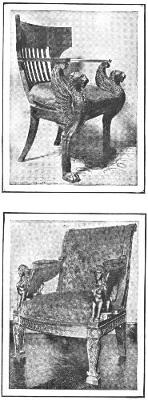
EMPIRE ARMCHAIRS
The new order, built on the overthrow of monarchical society and with no sympathy for delicacy and refinement, desired a setting free from the traditions of the past. The cabinetmakers, however, had only their training of the reign of Louis XVI, and this they could not transcend. For motives they had only their knowledge, or what they considered knowledge, of the antique. On this they endeavored to build a new style by direct adoption of classic forms. In chairs and couches they attempted to reproduce the actual shape used by the Greeks and Romans. Figures of caryatids and sphinxes take the place of simpler structural supports in tables and stands.
Ormolu was no longer employed in an architectural manner in which one decorative detail is set off against another in a play of rhythm and contrast; but was applied as single figures or small ornamental motives on a plain surface of mahogany. Oftentimes this ornament has so little relation to the space decorated that it could well be omitted without loss of real effectiveness. This enthusiasm for the antique passed through Egyptian, Greek, and Roman phases. Heavy and unimaginative as most of the Empire pieces seem, it can at least be said that they are more consistent and satisfying than the inharmonious mixture that characterized the furniture of the last year of Louis XVI. Many of the Empire chairs indeed are of real dignity and beauty of proportion. In some of these ormolu, introduced for the first time in chairs, was used in combination with polished mahogany; but in most cases the woodwork was sparingly carved with rosettes and enameled in white and gold. For the coverings, silk brocade and appliqué in the prevailing colors of yellow and red took the place of tapestry.

JEWEL CABINET OF MARIE LOUISE
LATE EMPIRE

EMPIRE ARMCHAIR
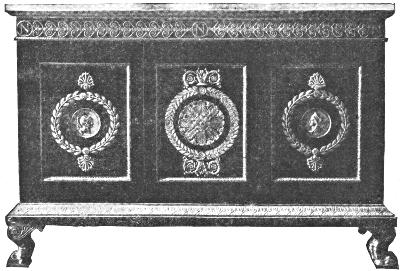
EMPIRE COMMODE
CHIPPENDALE—THE MASTER OF LINE

CHIPPENDALE PIECRUST TABLE
The French styles were the result of many designers working upon common lines; but in England during the last half of the eighteenth century certain noted individual cabinetmakers set the fashion, and for a period of years the designs of Chippendale, Heppelwhite, and Sheraton were each in turn recognized as the established vogue.
Thomas Chippendale began business in London on his own account about 1735, and evidently rapidly built up a very flourishing establishment, inasmuch as the “Gentleman and Cabinet-maker’s Director,” which he published in 1754, contains a wide variety of designs suitable only for wealthy customers.

CHIPPENDALE SETTEE—FRETWORK
The “Director” contains many designs that are fantastic, and many that are difficult and even impossible to execute. Fortunately Chippendale’s fame does not rest upon these designs, made to catch the eyes of his richer patrons, but upon the pieces actually made, and it is refreshing to see how much finer are these latter, evolved by the trained craftsman, understanding every limitation and every possibility of his material. Chippendale’s chairs represent by far the best expression of his genius. Starting with the modified Dutch forms introduced by William and Mary and Queen Anne, in which the cabriole leg with ball and claw feet and the flowing curved back with solid splat are the prominent features, he soon developed an individual style marked by great dignity, strength, and originality. His earliest chairs are perhaps the finest. In these the cabriole leg is always employed, and the side frames of the back curve outward as they run up to more or less pronounced ears at the top. The top rail takes more or less of a cupid bow shape, and the central splat fills in the inclosed space. It is in the design of these central splats and the inclosed framework that Chippendale is at his best. The almost inexhaustible variety of figure in these pierced and interlaced centers, always in the happiest relation to the framework, gives the principal interest to these chairs, and stamps Chippendale as one of the great masters of design.
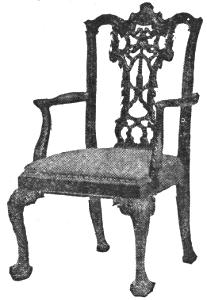
CHIPPENDALE ARMCHAIR
Chippendale’s styles represent many influences. His early work was patterned closely upon Queen Anne models; but with the “Director” appeared many examples of Gothic and fretted furniture. The Gothic, unsuitable as it was for domestic use, obtained little vogue; but the ornamentation of chairs and tables, either by open or, more commonly, applied fretwork, was popular for a dozen years or more, and is characteristic of some of Chippendale’s most successful if not most showy productions.
During this same period a rage for things Chinese possessed the popular taste, and in many latticed chair backs and canopied tops of cabinets the versatile cabinetmaker catered to this new interest.
Besides his chairs, the name of Chippendale is closely associated with the charming tripod tables, generally made with tilted top and often with molded or “piecrust” border, with the flat card tables so much used in the gaming of the period, and with the all-china cabinets and bookcases with glass fronts, and oftentimes with a characteristic broken pediment at the top.
The two other men who identified their names with English styles worked under the influence of the classical revival brought about in England largely by the influence of the brothers Adam. In the case of Heppelwhite this influence greatly affected but did not absolutely determine the style; for this practical cabinetmaker was a man of independent if not original ideas, and his work bears a strong stamp of individuality. Heppelwhite died in 1786, and the “Cabinet-maker and Upholsterer’s Guide,” published by his widow and partners in 1788, shows us in the form of a trade catalogue much of the spirit and quality of his work.
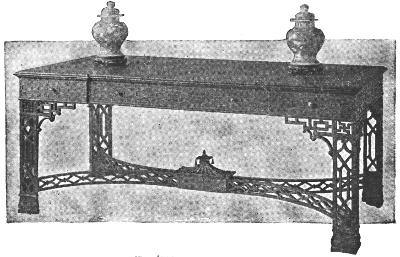
CHIPPENDALE TABLE
This table shows strong Chinese influence.
HEPPELWHITE—THE EXPONENT OF ELEGANCE

HEPPELWHITE CORNER CABINET
The most characteristic designs of Heppelwhite are his chair backs. These are commonly shield or oval shaped, with open center splats, in the center of which were often introduced the ostrich plumes of the Prince of Wales. Another form of back frequently employed by Heppelwhite was that with slightly curved sides and strongly bowed top, known as the “camel back.”
The legs of Heppelwhite’s chairs are almost always tapering and square in sections and end in a spade foot. The proportions of these chairs give an effect of extreme elegance and refinement. They seem almost fragile; but the material is disposed with such skill and the workmanship is so excellent that in reality they are far stronger than might appear.

EXAMPLES OF HEPPELWHITE CHAIRS
From the time of the Middle Ages the buffet has existed as an important article of furniture; but to Heppelwhite is due the credit of perfecting the sideboard in its present English form. He combined the pedestal cellaret and side table of Robert Adam in one structure, and effected a union of utility with elegance, which he executed in many pleasing designs of bow and serpentine front.
To Heppelwhite we must also give credit for the most refined and tasteful use of inlay and of veneers to be found in English furniture. On the doors of wardrobes and on the front of drawers he employed veneers of the beautiful curl mahogany that came into favor about 1760, and on the front of his solid mahogany tables, sideboards, and bookcases he substituted for carving the inlay of low-toned colored woods in the form of lines and narrow bands and other ornamental motives.

HEPPELWHITE COMMODE
SHERATON—THE PURIST
The last of the three great cabinetmakers represents the culmination of the classic spirit derived both from the brothers Adam and the French Louis XVI style. Sheraton’s productions, or rather his designs, depicted in the “Cabinet-maker and Upholsterer’s Drawing-Book,” have little of the vigor and strength of Chippendale’s work; but they are always characterized by delicacy and refinement.

EXAMPLES OF SHERATON CHAIRS
Sheraton designed furniture both in mahogany and in satinwood, decorated by inlay and by painting, and it is with this last style, the introduction of which was largely due to the popularity of the gifted young artist Angélique Kauffmann, that he is particularly identified. His work in mahogany is characterized by simplicity of form and by the tasteful use of inlay, in which respect he was perhaps the equal of Heppelwhite.
His chair backs are almost always based upon the straight line, and, although sometimes made petty by the introduction of inappropriate classic ornament, they exhibit on the whole much skill and refinement in composition. In the legs of chairs and tables he almost invariably used turned and tapering supports, which were frequently decorated by reeding. In the sides and often the backs of his chairs he reintroduced the vogue of canework, which had not appeared in fashionable furniture since the seventeenth century.
Sheraton’s satinwood furniture took the form mainly of commodes or bureaus, small writing desks, toilet tables, and other lighter articles for the boudoir. The daintiness and elegance of some of these pieces decorated by the brush of Angélique Kauffmann or Pergolesi challenge comparison with some of the exquisite furniture made during the reign of Louis XVI, and they mark the final culmination of English furniture before its degeneration into the mediocrity of later times.

SHERATON SIDEBOARD
SUPPLEMENTARY READING
| French Furniture | A. Saglio |
| A History of English Furniture | Percy Macquoid |
| French Furniture in the Eighteenth Century | Lady Dilke |
| Colonial Furniture in America | Luke Vincent Lockwood |
| English Furniture of the Eighteenth Century | Herbert Cescinsky |
| Furniture | Esther Singleton |
| French and English Furniture | Esther Singleton |
| The Furniture Designs of Thomas Chippendale | J. Munro Bell |

ANTIQUE CHEST—THIRTEENTH CENTURY
FURNITURE AND ITS MAKERS
Old Furniture
ONE

People have always used furniture; but the kind of furniture we use today is of comparatively recent origin. Wood, ivory, precious stones, bronze, silver, and gold have been used from earliest times in the construction and for the decoration of furniture, but modern furniture is a development of little more than four centuries.
Furniture has always varied in kind and style, according to the needs and customs of its users. There are few examples left of really ancient furniture. This is due partly to the perishable materials used in its making, and partly to the fact that the people of olden times had little furniture of any kind. Even the poorest home of today is better supplied with some household appliances than the most aristocratic house of splendid Egypt, tasteful Greece, or luxurious Rome.
And in the long period between the destruction of these ancient civilizations and the Renaissance the making of furniture developed very little. The rulers of Egypt were as well housed as the early kings of England. Household furnishings were the privilege of the great alone. No person of mean degree could or would dare to have used a chair—one of the commonest objects in every modern home. Active people, as they were, living much in the open air, they needed but benches on which to sit at meals, and beds on which to sleep. Our luxuries were not only unknown, but unnecessary to them.
The Egyptians used wooden furniture, carved and gilded; they also used chests in which to keep things. The tables and couches of the Assyrians were inlaid with ivory and precious metals. The wood used was mostly cedar and ebony. Solomon’s bed was of cedar of Lebanon. The furniture of Greece was oriental in form, and from this the Romans absorbed many ideas. The Roman tables were of marbles or rare woods. They used gold and silver plentifully, even cooking utensils being made of these precious metals.
Most medieval furniture of Italian make was richly gilded and painted. In the north of Europe carved oak was used to a greater extent. The feudal halls were furnished with benches carved and paneled. Chests of oak or Italian cypress were used as receptacles for clothes and tapestries. The oak coffer with wrought iron bands shown in the picture is of French make, of the latter half of the thirteenth century.
The Renaissance made a great change in furniture making. Cabinets and paneling were done in the outlines of palaces and temples. In Florence, Rome, Venice, and Milan there began on a large scale the manufacture of sumptuous cabinets, tables, chairs, and chests. Spain, France, and Germany soon followed the fashion, and in England Henry VIII greatly encouraged the art of furniture making.
Then came the great period of furniture, the eighteenth century. From being massive and exceedingly scarce and costly, furniture became light, plentiful, and cheap.
PREPARED BY THE EDITORIAL STAFF OF THE MENTOR ASSOCIATION
ILLUSTRATION FOR THE MENTOR, VOL. 1, No. 30, SERIAL No. 30

LOUIS XIV ARMCHAIR
FURNITURE AND ITS MAKERS
Boulle and Marot
TWO

There was no limit to the prices a reckless and profligate court was willing to pay for luxurious beauty during the sumptuous, extravagant reign of Louis the Magnificent of France. For much that was most splendid and beautiful in furniture making at this period stands the name of Charles André Boulle. His imagination and skill were given full play, and he proved equal to the demands made upon him.
Boulle was a remarkable man. In a court whose only thought was of pleasure and display, he realized that his furniture must not only excel all others in richness, beauty, and cost; it must also be both comfortable and useful. He was appointed cabinet maker to the Dauphin, the heir to the throne of France. This distinction, together with his own tastes, led him to copy some of the manners and bearing of his rich customers.
He was an aristocrat among furniture makers. He spent the greater part of his large fortune in filling his workshop with works of art. His warehouses were packed with precious woods and finished and unfinished pieces of magnificent furniture. In his own rooms were priceless works of art, the collection of a lifetime—gems, medals, drawings, and paintings, which included forty-eight drawings by Raphael.
Boulle’s ruin came in a single night. When he was seventy-eight years old all his property was destroyed by fire. His loss was not only of fortune, but of reputation as well; for when he was down and out he resorted to tricks and questionable dealings which brought him many lawsuits. He died in debt and poverty, a discredited and broken man.
The English court vied with France in its extravagance, and heaped honors and wealth on the man who, like Boulle, in France, was foremost among designers of furniture in that country. The authorities on fine furniture frequently speak of Marot’s work in connection with that of the great Boulle. Daniel Marot was the son of Jean Marot, an architect and engraver. After he went to England with William III he principally concentrated his talent upon the adornment of Hampton Court Palace. Much of the furniture at Hampton Court bears unmistakable traces of his authorship. At Windsor Castle also there is a silver table that is attributed to him.
Marot’s work differs from that of Boulle in that he inserted, in medallion form, pictorial subjects in a heavy framework of ornament. In other pieces the inlay took the form of geometrical, floral, and animal patterns, combined with the warmer and more beautiful tints of the exotic woods. The whole was marked by an unsurpassed degree of excellence in workmanship.
Besides furniture, Marot designed carved chimney pieces, panels for walls, ceilings, and wall brackets. He was also famous as a designer of gold and silver plate, and he even made tea urns and cream jugs.
PREPARED BY THE EDITORIAL STAFF OF THE MENTOR ASSOCIATION
ILLUSTRATION FOR THE MENTOR, VOL. 1, No. 30, SERIAL No. 30

LOUIS XV SIDEBOARD—MADE BY RIESENER
FURNITURE AND ITS MAKERS
J. H. Riesener
THREE

The early years of the life of Jean Henri Riesener would seem to indicate that he was born under a lucky star. But long before his death, at the age of seventy-one, in the first decade of the nineteenth century, his star had set. Before the outbreak of the French Revolution he commanded enormous prices for his work. One small table that he constructed is said to have been sold for more than a thousand dollars. Yet in his old age he was only saved from utter ruin by his son, a portrait painter.
Œben, the famous and successful furniture maker, under whom Riesener served as an apprentice, died and left, besides a young and handsome widow, one of the largest workshops in Paris and a large fortune. The young man promptly married the widow, and upon her death, six years later, came into possession of both the property and the fortune. Three years later he married the daughter of a citizen of Paris; but again his marriage proved of short duration, for after a few stormy years of wedded life he took refuge in the new divorce laws of the country, and returned again to the state of single blessedness.
Œben, his master, had been commissioned by King Louis XV of France to make a bureau. King Louis was called the “well beloved,” although he was really hated by the majority of his subjects. This bureau contributed greatly to Riesener’s fame; for its construction took three years, and, Œben having died in the meantime, his pupil completed it.
The massive bronze doors of this royal bureau were ornamented with elaborate and intricately modeled figures, and the whole was fashioned after a complete and perfect miniature model. The degree of craftsmanship that was brought to bear upon this historical piece of furniture was of such a character that a second bureau, built similarly, was begun and completed by a competitor before the original was finished.
Riesener became a greater artist than his teacher, Œben, and was recognized as one of the leading furniture makers of his time. His great activity is shown by the quantity and elaborate detail of the furniture he made.
At the beginning of the French Revolution evil days came upon Riesener. Those wealthy customers who did not flee and escaped the guillotine were made bankrupt. In 1793 he held a sale of his prized collection of furniture; but he was forced to buy most of it back himself. A little later he tried again to realize some money on the furniture; but this also was a failure.
His son, who had joined the army, returned to Paris and saved the aged furniture maker from starvation.
PREPARED BY THE EDITORIAL STAFF OF THE MENTOR ASSOCIATION
ILLUSTRATION FOR THE MENTOR, VOL. 1, No. 30, SERIAL No. 30

INTERIOR SHOWING THREE CHIPPENDALE CHAIRS
FURNITURE AND ITS MAKERS
Thomas Chippendale
FOUR

A young art student came to a furniture shop in London and the talk was of beauty of line, the dignity of proportion, and the introduction of mahogany in the manufacture of furniture. The art student afterward became Sir Joshua Reynolds, the world famed painter. The furniture maker was Thomas Chippendale, known as “King of the Eighteenth Century Furniture Designers.” And to these early friendly talks and arguments Chippendale attributes his reputation as a master of line and a genius of proportion.
Before the time of Chippendale most of the furniture was made of the heavier native woods, such as walnut or oak. Mahogany made a powerful appeal to him, because of its highly polished surface and the exquisite beauty of the wood itself; for the young cabinet maker who came up to London from Worcestershire had a passionate love of beauty and he was a master workman. From his father, who had achieved considerable local fame, he inherited this love, and he had learned how to make the wood carvings that are characteristic of his designs.
After a fire he converted four adjacent dwelling houses into a shop, which was situated on St. Martins Lane, in the fashionable section of London; and because he protested against the amount of his taxes it seems probable he was prosperous. Moreover, he belonged to the Society of Arts, with Gibbon the historian, Richardson the novelist, Dr. Johnson the lexicographer, and Horace Walpole the politician. If you add to this that he married in 1748 and died in 1779, there is summed up practically all there is known of Thomas Chippendale himself.
Chippendale made beautiful furniture. He was recognized by both the nobility and gentry, not only as an authority on the subject, but as an artist. He was probably better known as a designer of chairs than of any other form of furniture. Chippendale was familiar with artistic designs in Japan, Italy, and Spain, and was ready always to take ideas from the humble as well as the great, as is shown from the fact that subscribers to his book, “The Gentleman and Cabinet-maker’s Director,” range from the Duke of Northumberland to a local bricklayer. A large part of his reputation is attributed to this book, which was not so much a guide to his finished productions as an outline of the designs he would like to make. And these designs have served as a guide to furniture makers ever since.
PREPARED BY THE EDITORIAL STAFF OF THE MENTOR ASSOCIATION
ILLUSTRATION FOR THE MENTOR, VOL. 1, No. 30, SERIAL No. 30

LOUIS XVI CHAIR, WITH BEAUVAIS TAPESTRY
FURNITURE AND ITS MAKERS
Thomas Sheraton
FIVE

At forty years of age Thomas Sheraton was a poverty-pinched journeyman cabinet maker and Baptist preacher in Stockton-on-Tees. Then in 1790 he went to London, where he found even a greater poverty, but where he made for himself as a designer of furniture a name that will last as long as the world loves beautiful things. The fifteen remaining years of his life were tragically sad.
Sheraton’s knowledge was gained through years of hardship and privation. He lived to see his chosen art reach its zenith, and then to see it fall away. He had scarce perfected his creations when they were overwhelmed by a wave of bad taste that swept much beauty from English furniture.
When Sheraton reached London he hadn’t enough money to set up shop, much less to employ skilled workmen. So, instead of making furniture, he wrote about it, varying this occasionally by writing sermons or tracts. He made little money, but many enemies, for he had a bitter tongue.
Adam Black, afterward the famous publisher, was then a printer’s apprentice, and lived for a time in Sheraton’s humble home. “The night I arrived,” Black wrote, “there were but two cups and saucers, one of which I used, Sheraton’s wife sharing her young daughter’s porridge bowl.”
Black published Sheraton’s “Encyclopedia of Furniture.” This brought Sheraton some fame, but little food. The big work showed the great range and variety of Sheraton’s art.
We love his furniture for its finely curved surfaces, graceful sweeps of sideboards and cabinets reflecting the light. Aside from its beauty, Sheraton’s furniture was essentially practical—sometimes in most original fashion. For example, he invented a summer bed, divided in the center so as to give a greater circulation of air. There was likewise a hollow-front sideboard that became popular for the ease with which a butler could reach across for a stray glass or piece of china ware. His “conversation chair” was designed for the beaux of Georgian times, whose coat-tails were too costly to be sat upon. The proper position in this chair was for the sitter to face the back of the chair, with his arm resting on the top rail, so that his coat-tails could hang. The so-called “Pouch Table,” much beloved today by neat housewives, was Sheraton’s invention. It was a work table with a pouch of silk on each side.
Besides his great book, Sheraton got up a handbook for the benefit of his brother craftsmen, in which he gave in a helpful manner minute descriptions of his various pieces. The spirit that prompted him to do this was the finest thing in Sheraton’s nature. He had his faults. He was narrow, self-centered, and bitterly resentful of the success of others, but he believed it to be a man’s duty to give to the world the benefit of his full knowledge, and he sacrificed himself through life to do this.
PREPARED BY THE EDITORIAL STAFF OF THE MENTOR ASSOCIATION
ILLUSTRATION FOR THE MENTOR, VOL. 1, No. 30, SERIAL No. 30

LOUIS XVI CABINET
FURNITURE AND ITS MAKERS
George Heppelwhite
SIX

George Heppelwhite was one of the great names in furniture making. His wife published after his death a book, “The Cabinet Maker and Upholsterer’s Guide, or Repository of Design for Every Article of Household Furniture in the Newest and Most Approved Taste,” on which his reputation rests. This book went through three editions in 1788, two years after the author’s own death.
The designs in his book are characterized by comfort rather than artificiality. With this is combined great technical excellence and extreme lightness and durability. Curiously, however, these designs are not all of equal value. Some are as good as the best work of any era, while others are most commonplace.
Although even at that time tea cost five dollars a pound, its use had become very popular throughout England. Heppelwhite introduced many articles that had to do with the tea service. Many peculiarly constructed and choice urn stands, tea trays, chests, and caddies are attributed to him.
Heppelwhite’s furniture had an interesting characteristic. The legs tapered delicately on the inside faces only, and were finished with a square foot. This gave the impression of grit and power to otherwise fragile furniture.
There were several stock designs, or ornaments, of which this furniture maker made frequent use. He was particularly fond of inserting ovals in the backs of his chairs. Frequently a carved ear of corn was used as a decoration. Heppelwhite also made abundant use of a Prince of Wales feather in delicate carving, combined with an inlay of colored woods. This use of the royal plume was attributed to his loyalty to the Prince of Wales. It was conclusive proof of the popularity of the Prince’s party when the illness of George III caused such national strife.
The fact that Heppelwhite was accused by his enemies of plagiarism does not detract a bit from his real position. It shows rather that, like all real artists, he remained a student until the close of his career. He never disdained to profit by the experience and teachings of others, even those less eminent than himself.
PREPARED BY THE EDITORIAL STAFF OF THE MENTOR ASSOCIATION
ILLUSTRATION FOR THE MENTOR, VOL. 1, No. 30, SERIAL No. 30